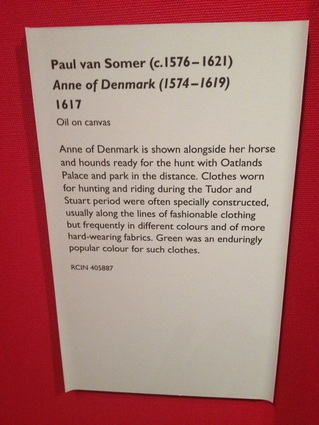 Detail showing man in red, from P. Van Somer, 'Anne of Denmark' (1617).
Detail showing man in red, from P. Van Somer, 'Anne of Denmark' (1617). It seems odd that such a finely dressed young man should be entirely overlooked in an exhibition devoted to fashion. The colour of his garment is one that is associated with royalty elsewhere in the exhibition, the lace of his collar is very fine, and the artist has lovingly rendered the red ribbon of his shoe. And yet somehow, he has disappeared into the background of Paul Van Somer's painting, unworthy of mention.
I was so excited to finally see this painting in the flesh, after having written about it and used it to illustrate lectures. The silence surrounding Anne of Denmark's African groom was deafening for me.
I took some comfort in the fact that there was no mention of the groom in the adjoining painting of Prince Henry either. Indeed the exhibition had nothing to say on the subject of servants' fashion.
Of course my instinctive reaction was to immediately start telling the old man standing next to me all about the black presence in Stuart Britain, then to take lots of pictures (it was kind of the Royal Collection to allow photography) with this blog in mind.
So, what ought the curators have mentioned about this other man in red? Well, here it's my turn to go red, as I don't know his name, or anything else about his life. But I can provide you with some compelling context!
We know that there were Africans working in royal and aristocratic stables across Europe. A painting of c.1630-2 by Daniel Mytens shows an African groom bringing Charles I and Henrietta Maria their horses.
We know from household and treasurer's accounts that Anne of Denmark had an African in her household back in Edinburgh, c.1590-94. She also commissioned and performed with her ladies in Ben Jonson’s Masque of Blackness in 1605 and its sequel, the Masque of Beauty (1606), in which the black daughters of Niger seek "beauty" and become white, thanks to the rays of the British sun (which represented King James).
Going back to the painting, I was curious about the palace in the background, as this might be some clue to where the man in red lived. I learnt that this was Oatlands Palace, which James I granted to his wife in 1611. She made many improvements, including: "a new brick wall to compass and enclose her majesties vineyard at Otelands and the long privy walle addoiyninge to the same ass in levellinge the grene above the vineyarde being trenched very deep to kill the ferne rootes and making a Silkewormehouse ... seates of wainscott to stande in the vineyard ... A false dove for the privy walke..." The only part of the palace that remains today is a c.1545 entrance gate and part of the walls, swamped by suburban housing in Elmbridge, Surrey.
So, perhaps we can have a Google Art Talk on this equally enigmatic man in red, or even better a whole exhibition devoted to the many Africans in British Portraits?



 RSS Feed
RSS Feed
